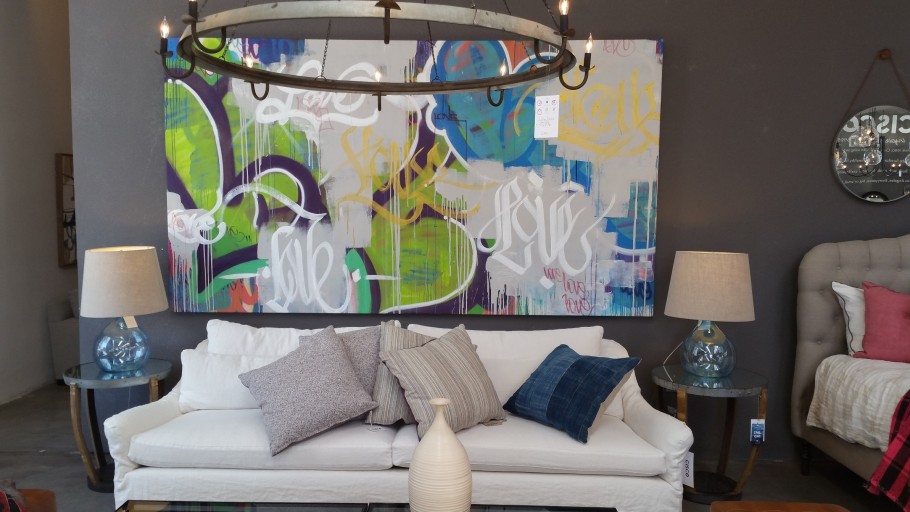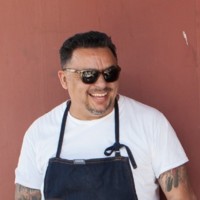Karlos Marquez
"LOVE IS ALL": KARLOS MARQUEZ ON GRAFFITI, THE CORPORATE WORLD AND COMMUNITY LIFE

ON ART AND AESTHETICS BY TULIKA BAHADUR
"LOVE IS ALL"
Los Angeles-based Karlos “BUMPS” Marquez (born 1968) has been contributing to the local art scene since 1984—when he first created graffiti with friends under the name of “Kartoon”. He continued to develop his style by pursuing art at Los Angeles City College and the “Associates of Art” school in Sherman Oaks, where he studied life drawing and full figure drawing with artist, illustrator, and instructor Mark Westermoe.
Today, after many years in the corporate world, Karlos is a full-time artist. He inscribes his bright, colorful, and energetic graffiti on canvas and furniture. In his practice, he brings business acumen, which operates alongside a thoughtful sense of social responsibility.

Karlos Marquez
I spoke to Karlos recently about his passion for graffiti, his partnerships and collaborations, community work, and the role of artists in dark times.
You were raised in the Pico-Union Central Area of Los Angeles which has a large Hispanic/Latino population. Tell me more about the cultural context in which you grew up. What sort of art was available to you as a child and adolescent?
The art available was the Watts Towers, murals near our corner stores, the graffiti on the walls, and the influence of what I saw on TV, read in magazines and books (Jackson Pollock, Antoni Tapies, Franz Kline, Andy Warhol, etc.). My friend’s father Matsumi Kanemitsu was also an important figure in the world of local art. The museums in close proximity offered a variety of styles that were refreshing and thought-provoking.
When and how did you develop a fascination with graffiti?
I was influenced by the lettering in different styles of gang graffiti. They were by true artists. Their style was really impressive. As a teenager, I was introduced to graffiti through a book by Martha Cooper and Henry Chalfant called Subway Art. It was on the graffiti found on trains in New York. I was fascinated by it because here I was looking at art being done by kids on the street as opposed to something in the museums by renowned artists, which meant that it was feasible for someone like me. Also, the documentary Style Wars (1983) on PBS made quite an impact on me. Then there were cartoons by Warner Brothers that deepened the interest.

A painting

A print
Next, why did you decide to make graffiti your own style? What do you find so exciting about it? Personally, I have always been interested in it. To some, it may seem rough and untidy, an indication of noisy disobedience and dissent. But to me, text and color and image scrawled on old walls or trains in busy cities is a sign of vitality and energy, even intellectual dynamism. I also like the fact that graffiti is such an easily attainable medium of creativity. In politically tumultuous areas with extreme censorship (e.g., the Middle East of today), where artists may not have access to canvas or paper or film, they can always spray messages on the nearest wall as a form of social protest. It really works, I guess. So what are your thoughts on the nature and importance of graffiti?
It is a powerful statement and sometimes even more eloquent than words. It is irreverent, rebellious, and non-conformist. By its very nature, it exists outside of the mainstream culture, yet it is very telling of present times. It effectively reveals the thoughts and feelings of society.
You have created a broad range of mixed media pieces including large canvas works and fabric, furniture, and metal pieces that are on display at Cisco Home stores in Santa Monica, Costa Mesa, Melrose, Pasadena, San Francisco, Nashville, TN, Ponte Verda, FL, and New York. This is such a good way to commercialize and democratize art—fine artists teaming up with furniture, interior design, and clothing brands. I’d like to learn more about your association with Cisco Home. How did it come about? Also, would you like to offer some advice/tips to artists dreaming of taking their designs/messages to the “masses”?
I met Cisco through his brother, Pepe Pinedo from Wise Living, Inc., a sustainable wood furniture manufacturer in Los Angeles, Pepe thought that my artwork would complement the style and vision of Cisco Home.
I talked to Cisco about doing graffiti on the furniture. I explained that back in the 80s, we used to do graffiti on the denim we wore. I thought it would be interesting to do graffiti on denim-covered furniture and he was open to the idea. This lead to my doing graffiti on ottomans, draperies, coffee tables, sofas, pillows, and mirrors, all of which were displayed at Cisco Homes and offered for sale. We have had a mutually beneficial relationship where he not only supports my vision but believes in me as an artist. He has given me the freedom to express myself, without limits and I have become his resident artist.
The advice I would give to artists wanting to take their art to the wider public is to persevere. If you have a style and vision, or if you are still developing your style and vision, don’t get discouraged.
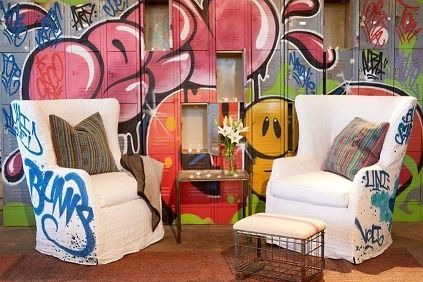
Graffiti on sofas
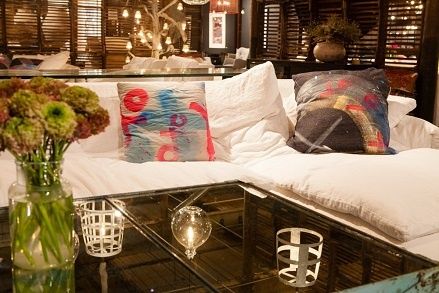
Graffiti on pillows
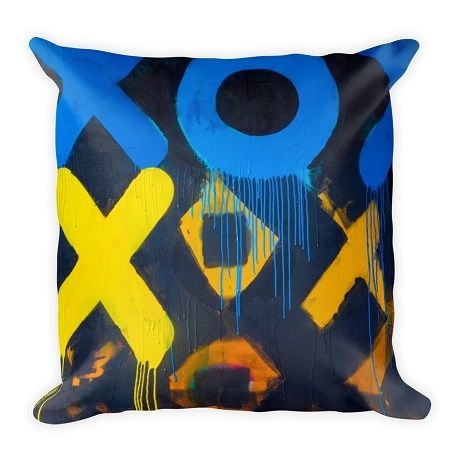
Graffiti on outdoor table and chairs
You’ve mentioned in a video on your site that you worked in the corporate world for a period of time. What are the biggest lessons you learned from your 9-to-5 existence that you now apply to your artistic practice?
Lesson #1: It takes discipline, just like anything else. Lesson #2: Creativity and out-of-the-box thinking may not always be rewarded in the corporate world, but you have complete freedom to express yourself in the way you want in your art, and that is rewarding. Lesson #3: It takes passion and commitment to see it through. Lesson #4: I have learned how to take my art to both local and international markets and know how to manage it as a business. Lesson #5: I have learned how to conduct business with other corporate entities and understand their structures.
From the “Love” series
Both your “LOVE” and “NEON” series are incredibly attractive. Where did you get the idea from? What are you attempting to convey?
For the first one, I wanted to express the idea that “Love Conquers All”. I used fun and beautiful colors that capture people’s imagination and hearts. People are seeking love and trying to figure love out. My aim is to inspire love in others, especially in these dark times. As artists, we inevitably address the climate in which we live. My message is that love is all. That’s what unites us as human beings. It is a universal feeling that we have all experienced in one way or another. When in love, we are vulnerable, which means we are also open, innocent, creative and generous.

From the “Neon” series
Now, neon. Growing up, I was fascinated by the vintage signs made with neon and intrigued by the glow and sheer beauty of the light and material, whether it was at the liquor store or the movie theatre. I thought about how I might bring it into the home where it could have both form and function. I wanted to give my art a three-dimensional quality that could pop out my graffiti and grab the attention of the viewer. I strive to bring function and form together to create focal points in a room that will capture both the eye and the imagination.
You believe strongly in “giving back to the community” that has helped you develop your vocation. You contribute to various initiatives: the Tempt One ALS foundation, the META Foundation, and The Ron Finley Project. Could you elaborate on your involvement in each of these?
I understand first-hand what it feels like to struggle, to be the underdog. I have always told myself that if I am ever in a position to help someone, even in the smallest of ways, that I would not hesitate. It feels good to know that I can make a difference in the lives of others.
The META Foundation is a non-profit organization that provides college scholarships to inner-city Latino students. I have donated my time and art to raise funds that can cover tuition.
The TEMPT One Foundation is a non-profit foundation that was created to spread awareness of Lou Gehrig's disease or Amyotrophic lateral sclerosis (ALS) and to help artists with it. I have donated my time and art to generate funds for this worthy cause. One of my friends is afflicted with this condition and I am committed to supporting the research.
The Ron Finley Project is focussed on bringing fruit and vegetables to the inner city by creating urban community gardens and promoting the nutritional value of healthy eating. I have donated my time and art here as well as I am an advocate of a healthy mind and a healthy body. As the saying goes, your health is your wealth.

Meta Foundation

College scholarships provided by the META Foundation

The Ron Finley Project

Gardening for Ron Finley
A question related to the previous one: what, in your view, should/could the role of an artist be in society?
In my opinion, an artist’s role should be to provide hope, to provide beauty, as well as offer commentary on contemporary issues. Art is another language altogether, a means of expressing yourself that is not limited by words but open to a multitude of worlds, feelings, and ideas.
You have an interesting collaboration with artist Kris Cunz. The final images (prints and paintings) are records of graffiti supposedly found on corners and crossroads, by shops and fields. What is so great about such partnerships?
Collaborations are my favorite because you have two creative minds working together but with their own twist on the same project or piece of artwork. You see it a lot in music so why not in art?
n my opinion, an artist’s role should be to provide hope, to provide beauty, as well as offer commentary on contemporary issues. Art is another language altogether, a means of expressing yourself that is not limited by words but open to a multitude of worlds, feelings and ideas.
You have an interesting collaboration with artist Kris Cunz. The final images (prints and paintings) are records of graffiti supposedly found on corners and crossroads, by shops and fields. What is so great about such partnerships?
Collaborations are my favorite because you have two creative minds working together but with their own twist on the same project or piece of artwork. You see it a lot in music so why not in art?

700 (with Kris Cunz)
What do you like about “public” art and what do you like about “private” art?
As a teenager, I started painting in public places not always with permission. I got to paint with friends and other artists from different cities. It’s fun to create artwork through which the world gets to see our vision or message. This is seen a lot more these days with very large murals on the sides of commercial buildings. I’ve enjoyed painting for retail businesses as part of their decor or design. It’s also been exciting to me to bring my artwork into the home whether it’s a large mural that transitions from one room to the other or large canvas work. Here I can create something personal for the client to enjoy, which is nice.
Who are your favorite creative people?
Certainly Cisco Pinedo of Cisco Home. I have learned so much from him as a mentor and a businessman and a wonderful father. I’ve been inspired by his creative process, his unique furniture, how he gives back to his own community and others, including me. He is one of the reasons why I get to create every day, why I keep pushing my artwork and designs.
Dr. Dre has inspired me because he comes from the same neighborhoods I grew up in and has shown the world that you can touch the sky and be successful if you work hard and believe in yourself as an artist and recognize the artistry of others. Then there’s Ellen DeGeneres—with her ability to make me see the world without the filters of race or creed. I truly admire her sense of pride and her love for others.
Tom Ford is one of my favorite designers because of what he did at Gucci but more importantly, because of his own brand. His designs are beautiful pieces of art that people get to wear. Steve Jobs—for his amazing and innovative devices that the whole world gets to enjoy. I really appreciate the fact that he did it his way regardless of what others thought or wanted. Bill Gates for bringing the world closer to his technology, but I am also inspired by his kind heart and his desire to give back to the whole world. The list goes on…What are you working on at the moment? Furniture pieces and community projects. What do you love most about Los Angeles? And what would you like to change about your city if you had the chance? I love all the different cultures and people, also the variety of food. I can easily go a whole month without having the same thing twice. What would I love to change about LA? If I could…it would be the homelessness. There are about 59,000 people on the streets in my city. I would like to build their homes from shipping containers, with reclaimed materials as furnishings. Find Karlos on his Facebook (www.facebook.com/karlosbumpsmarquez), Instagram (www.instagram.com/karlosmarquezart
or website www.karlosmarquez.com
His art is available on Museum Editions (museum-editions.com/blogs/museum-editions-blog/artist-feature-karlos-bumps-marquez).
